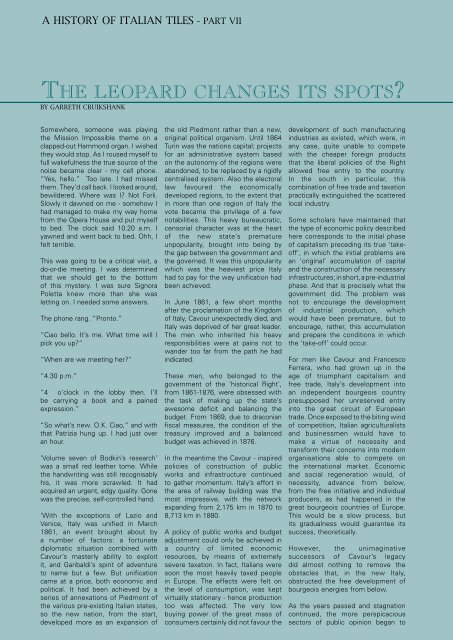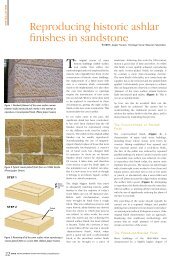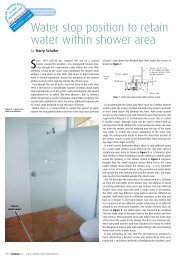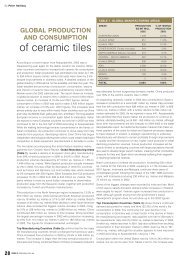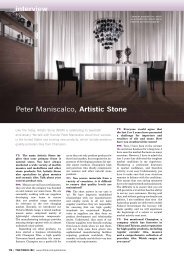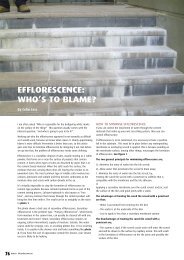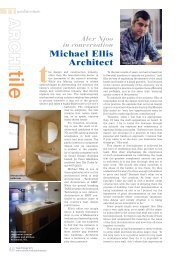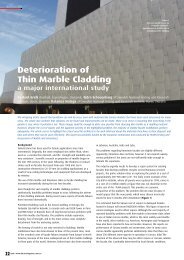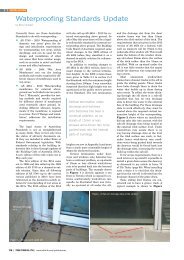A History <strong>of</strong> <strong>Italian</strong> Tiles - Part viiThe leopard changes its spots?By Garreth CruikshankSomewhere, someone was playingthe Mission Impossible theme on aclapped-out Hammond organ. I wishedthey would stop. As I roused myself t<strong>of</strong>ull wakefulness the true source <strong>of</strong> thenoise became clear - my cell phone.“Yes, hello.” Too late. I had missedthem. They’d call back. I looked around,bewildered. Where was I? Not Forli.Slowly it dawned on me - somehow Ihad managed to make my way homefrom the Opera House and put myselfto bed. The clock said 10.20 a.m. Iyawned and went back to bed. Ohh, Ifelt terrible.This was going to be a critical visit, ado-or-die meeting. I was determinedthat we should get to the bottom<strong>of</strong> this mystery. I was sure SignoraPoletta knew more than she wasletting on. I needed some answers.The phone rang. “Pronto.”“Ciao bello. It’s me. What time will Ipick you up?”“When are we meeting her?”“4.30 p.m.”“4 o’clock in the lobby then. I’llbe carrying a book and a painedexpression.”“So what’s new. O.K. Ciao,” and withthat Patrizia hung up. I had just overan hour.‘Volume seven <strong>of</strong> Bodkin’s research’was a small red leather tome. Whilethe handwriting was still recognisablyhis, it was more scrawled. It hadacquired an urgent, edgy quality. Gonewas the precise, self-controlled hand.‘With the exceptions <strong>of</strong> Lazio andVenice, Italy was unified in March1861, an event brought about bya number <strong>of</strong> factors: a fortunatediplomatic situation combined withCavour’s masterly ability to exploitit, and Garibaldi’s spirit <strong>of</strong> adventureto name but a few. But unificationcame at a price, both economic andpolitical. It had been achieved by aseries <strong>of</strong> annexations <strong>of</strong> Piedmont <strong>of</strong>the various pre-existing <strong>Italian</strong> states,so the new nation, from the start,developed more as an expansion <strong>of</strong>the old Piedmont rather than a new,original political organism. Until 1864Turin was the nations capital; projectsfor an administrative system basedon the autonomy <strong>of</strong> the regions wereabandoned, to be replaced by a rigidlycentralised system. Also the electorallaw favoured the economicallydeveloped regions, to the extent thatin more than one region <strong>of</strong> Italy thevote became the privilege <strong>of</strong> a fewnotabilities. This heavy bureaucratic,censorial character was at the heart<strong>of</strong> the new state’s prematureunpopularity, brought into being bythe gap between the government andthe governed. It was this unpopularitywhich was the heaviest price Italyhad to pay for the way unification hadbeen achieved.In June 1861, a few short monthsafter the proclamation <strong>of</strong> the Kingdom<strong>of</strong> Italy, Cavour unexpectedly died, andItaly was deprived <strong>of</strong> her great leader.The men who inherited his heavyresponsibilities were at pains not towander too far from the path he hadindicated.These men, who belonged to thegovernment <strong>of</strong> the ‘historical Right’,from 1861-1876, were obsessed withthe task <strong>of</strong> making up the state’sawesome deficit and balancing thebudget. From 1869, due to draconianfiscal measures, the condition <strong>of</strong> thetreasury improved and a balancedbudget was achieved in 1876.In the meantime the Cavour - inspiredpolicies <strong>of</strong> construction <strong>of</strong> publicworks and infrastructure continuedto gather momentum. Italy’s effort inthe area <strong>of</strong> railway building was themost impressive, with the networkexpanding from 2,175 km in 1870 to8,713 km in 1880.A policy <strong>of</strong> public works and budgetadjustment could only be achieved ina country <strong>of</strong> limited economicresources, by means <strong>of</strong> extremelysevere taxation. In fact, <strong>Italian</strong>s weresoon the most heavily taxed peoplein Europe. The effects were felt onthe level <strong>of</strong> consumption, was keptvirtually stationary - hence productiontoo was affected. The very lowbuying power <strong>of</strong> the great mass <strong>of</strong>consumers certainly did not favour thedevelopment <strong>of</strong> such manufacturingindustries as existed, which were, inany case, quite unable to competewith the cheaper foreign productsthat the liberal policies <strong>of</strong> the Rightallowed free entry to the country.In the south in particular, thiscombination <strong>of</strong> free trade and taxationpractically extinguished the scatteredlocal industry.Some scholars have maintained thatthe type <strong>of</strong> economic policy describedhere corresponds to the initial phase<strong>of</strong> capitalism preceding its true ‘take<strong>of</strong>f’,in which the initial problems arean ‘original’ accumulation <strong>of</strong> capitaland the construction <strong>of</strong> the necessaryinfrastructures; in short, a pre-industrialphase. And that is precisely what thegovernment did. The problem wasnot to encourage the development<strong>of</strong> industrial production, whichwould have been premature, but toencourage, rather, this accumulationand prepare the conditions in whichthe ‘take-<strong>of</strong>f’ could occur.For men like Cavour and FrancescoFerrera, who had grown up in theage <strong>of</strong> triumphant capitalism andfree trade, Italy’s development intoan independent bourgeois countrypresupposed her unreserved entryinto the great circuit <strong>of</strong> Europeantrade. Once exposed to the biting wind<strong>of</strong> competition, <strong>Italian</strong> agriculturalistsand businessmen would have tomake a virtue <strong>of</strong> necessity andtransform their concerns into modernorganisations able to compete onthe international market. Economicand social regeneration would, <strong>of</strong>necessity, advance from below,from the free initiative and individualproducers, as had happened in thegreat bourgeois countries <strong>of</strong> Europe.This would be a slow process, butits gradualness would guarantee itssuccess, theoretically.However, the unimaginativesuccessors <strong>of</strong> Cavour’s legacydid almost nothing to remove theobstacles that, in the new Italy,obstructed the free development <strong>of</strong>bourgeois energies from below.As the years passed and stagnationcontinued, the more perspicacioussectors <strong>of</strong> public opinion began to
suspect that the prospect <strong>of</strong> alongdevelopment from below might not bebest suited to Italy, which had to makeup for a great deal <strong>of</strong> lost time andwas pressed by urgent problemsdemanding immediate attention. Thequestion was asked whether Italy toocould not take those short-cuts thathad allowed Germany, a few yearsafter its constitution as a nation, tobecome a great independent powerwhose products now reached themarkets <strong>of</strong> the world, and whosetechnical ability aroused the envy <strong>of</strong>all its competitors. So, somewhatconfusedly, there took shapethe prospect <strong>of</strong> a Prussian line <strong>of</strong>capitalist development: an economictransformation brought aboutfrom above, and with the state’scontribution as a determining factor,under the banner <strong>of</strong> protectionismand the reinforcement <strong>of</strong> the country’sinternational prestige.In about 1874 ‘economic Germanism’began to be discussed in Italy.This concept propounded the needto reconsider the free-trade biastraditionally part <strong>of</strong> <strong>Italian</strong> economicpolicy. That the state should act as anaccelerating force to the economy wassomething both admitted in theoryand practised by all the governmentswhat had ruled Italy. The economy’s‘modus vivendi’, the bond betweenthe bourgeois manufacturers andbusinessmen <strong>of</strong> the north and thesouthern landowners was alsomodelled on Bismarck’s Germany.In 1878 pressure from the textileand machine industries in the northsucceeded in winning a protectivecustoms tariff from the government.From that moment Italy’s economiclife became more sustained and themoney market more animated. Thisdevelopment was assisted also bythe introduction <strong>of</strong> new forms <strong>of</strong>credit specifically designed to financeinvestments on the French example.The new banks also moved in thisdirection. Some <strong>of</strong> the capital wasinvested speculatively: the 1880s sawthe first rush towards speculativebuilding. Rome was subject toindiscriminate demolitions, and thecentre <strong>of</strong> the capital emerged with apretentious new face, forever marredby a number <strong>of</strong> eyesores - <strong>of</strong> which themost monumental is without a doubtthe so-called ‘Altar <strong>of</strong> the Nation’. InFlorence and Naples the demolitionsquads were also active.But a considerable part <strong>of</strong> the capitalon the market was employed in moreproductive, long-term investments,in industry. The advance <strong>of</strong> themetal industry was spectacular;the chemical, machine and mineralindustries all made steady progress,and the electrical industry alsotook its first steps. All these areaswere essential to the ultimatetransformation <strong>of</strong> the tile sector into amodern industrial enterprise.On the whole the production <strong>of</strong> <strong>Italian</strong>industry made a general increase <strong>of</strong> 37per cent from 1881 to 1887, with anannual growth rate <strong>of</strong> 4.6 per cent.Italy’s first modest industrial boomcoincided with the beginning <strong>of</strong> thegreat agricultural crisis. The rise inprices <strong>of</strong> industrial products that wereprotected by customs barriers talliedwith the fall <strong>of</strong> agricultural prices,and the draining <strong>of</strong> capital from thecountryside <strong>of</strong> the town, from the southto the north steadily increased. Thearrival <strong>of</strong> American corn, made possibleby a drastic reduction in sea freightcharges created a crisis throughoutEurope, though in Italy it was the moreserious in that an agricultural system aspoor in capital as her’s was weak andunprepared to face it.figure AA four tile forerunner (12.5cm x 12.5cm)<strong>of</strong> the 20cm product that swept europein the 70’s, produced in 1903.Once again it was the poorest countrypeople who had to pay the price. Manywere seized by the desperate desireto escape from the downward spiral <strong>of</strong>poverty and degradation in which theywere trapped. At first unobtrusively,then with mounting speed, theretook shape the phenomenon <strong>of</strong> massemigration. Swarms <strong>of</strong> emigrantscrammed onto transatlantic shipsbound for the vast melting-pot <strong>of</strong>North America, or else tried theirchances as farmers in Latin America.In the five year period 1886-90 theaverage annual number <strong>of</strong> emigrantswas approximately 222,000.In 1887 a new tariff was drawn up,marking a very important step in the<strong>history</strong> <strong>of</strong> <strong>Italian</strong> capitalism, and maybe considered the birth certificate <strong>of</strong>what Gramsci called the ‘agriculturalindustrialbloc <strong>of</strong> the <strong>Italian</strong> dominantclasses’, for the new tariff raisedsubstantially the customs barriersprotecting the infant <strong>Italian</strong> industry.However, far from involving a process<strong>of</strong> levelling and <strong>of</strong> regeneration frombelow, the development <strong>of</strong> capitalismin Italy represented a widening <strong>of</strong> thealready immense social and regionalgaps existing in the country. The resultwas a social fabric in which new andold were juxtaposed and interwoven,in which a capitalism with a highdegree <strong>of</strong> monopolistic concentration,a close interrelationship <strong>of</strong> banks andindustry and state protection coexistedwith an agriculture that insome regions was still at a semifeudalstage, and with omnipresenthandicrafts at a cottage level.The five years from March 1896 toDecember 1900 are among the mostturbulent and spectacular <strong>of</strong> all the<strong>history</strong> <strong>of</strong> united Italy. Street uprisingswere bloodily repressed (with cannonfire), parliamentarians overturned thevoting-urns, there were anarchist acts<strong>of</strong> violence, duels between politicalleaders, and, finally, the assassination<strong>of</strong> a king. The picture <strong>of</strong> a century’send, pregnant with apocalyptic fearsand hopes, is complete.Nevertheless, the economic pictureduring this period was healthy. From1896-1908 the annual growth rate<strong>of</strong> <strong>Italian</strong> industry on the whole wasnoticeably high, at 6.7 per cent. Someexperimental industries such asmetallurgy, chemicals and machinery,all vital to the tile industry, showeda growth rate <strong>of</strong> more then 12 percent. The automobile industry madea dramatic surge forward. Motor carproduction companies multipliedrapidly, from seven in 1900 to seventyin 1907.But the protection enjoyed by Italy’sindustrial majors does not adequatelyexplain their rapid development. Thereis another factor to be taken intoaccount - the low cost <strong>of</strong> labour.At the beginning <strong>of</strong> the century the<strong>Italian</strong> worker was not only one <strong>of</strong>the worst paid in Europe, but alsoworked the longest hours, for therewas no law limiting the working day.As for wages, in spite <strong>of</strong> the increasesthat had followed the agitations andstrikes <strong>of</strong> the first years <strong>of</strong> the newcentury, the wide use <strong>of</strong> female andjuvenile labour did much to keepthem low.


